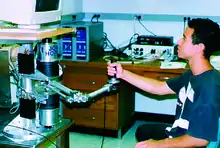Startle-evoked movement
Startle-evoked movement (SEM or startReact) is the involuntary initiation of a planned action in response to a startling stimulus. While the classic startle reflex involves involuntary protective movements, SEMs can be a variety of arm, hand and leg actions including wrist flexion, and rising onto tiptoes.[1] SEMs are performed faster than voluntary movements, but retain the same muscle activation characteristics.[1]

SEM has been used to study how the brain, spinal cord and brainstem can interact to produce movement,[2][3] and provides a potential avenue of exploration for rehabilitation strategies for those with neurological impairments.[4][5]
Neurophysiology
Reticulospinal tract connection
Muscles lacking reticulospinal tract inputs are not susceptible to SEM. The ability to elicit SEM has been used as evidence for reticulospinal tract connections to the muscles governing grasp of the human hand.[3]
Neurological impairment
People who have suffered cortical damage such as a stroke are capable of performing SEM.[4][6] In one experiment, SEM caused stroke survivors to perform arm movements as fast as unimpaired people, despite being slower when performing the same action voluntarily.[4] Furthermore, people with pure hereditary spastic paraplegia, a condition effecting the corticospinal tract, are susceptible to SEM as well.[5]
Involuntary initiation
SEM is typified by a reduction in the time to perform an action. Voluntary arm extension, for example, occurs roughly 170 milliseconds after a "Go" signal, while SEMs for arm extension occur between 65-77 milliseconds.[1] Due to this faster reaction time, and considering conduction velocity, cortical involvement for these movements is unlikely.
Movement preparation
In order for SEM to occur, a subject must be waiting to perform an action when a startling stimuli is encountered.[2] Typically, this is achieved by first presenting the subject with a "Ready" signal, indicating that the subject should prepare to conduct a specified action; then playing a startling acoustic stimuli (SAS) before the "Go" signal the subject is anticipating.
References
- Valls-Solé, Josep; Rothwell, John C; Goulart, Fatima; Cossu, Giovanni; Muñoz, Esteban (1999-05-01). "Patterned ballistic movements triggered by a startle in healthy humans". The Journal of Physiology. 516 (Pt 3): 931–938. doi:10.1111/j.1469-7793.1999.0931u.x. ISSN 0022-3751. PMC 2269293. PMID 10200438.
- Carlsen, Anthony N.; Chua, Romeo; Inglis, J. Timothy; Sanderson, David J.; Franks, Ian M. (2004-12-01). "Can prepared responses be stored subcortically?". Experimental Brain Research. 159 (3): 301–309. doi:10.1007/s00221-004-1924-z. ISSN 0014-4819. PMID 15480608. S2CID 24318160.
- Honeycutt, Claire Fletcher; Kharouta, Michael; Perreault, Eric Jon (2013-10-01). "Evidence for reticulospinal contributions to coordinated finger movements in humans". Journal of Neurophysiology. 110 (7): 1476–1483. doi:10.1152/jn.00866.2012. ISSN 1522-1598. PMC 4042417. PMID 23825395.
- Honeycutt, Claire Fletcher; Perreault, Eric Jon (2012-08-30). "Planning of Ballistic Movement following Stroke: Insights from the Startle Reflex". PLOS ONE. 7 (8): e43097. Bibcode:2012PLoSO...743097H. doi:10.1371/journal.pone.0043097. ISSN 1932-6203. PMC 3431358. PMID 22952634.
- Nonnekes, Jorik; Oude Nijhuis, Lars B.; de Niet, Mark; de Bot, Susanne T.; Pasman, Jacobus W.; van de Warrenburg, Bart P. C.; Bloem, Bastiaan R.; Weerdesteyn, Vivian; Geurts, Alexander C. (2013-12-31). "StartReact Restores Reaction Time in HSP: Evidence for Subcortical Release of a Motor Program". Journal of Neuroscience. 34 (1): 275–281. doi:10.1523/jneurosci.2948-13.2014. PMC 6608175. PMID 24381288.
- Honeycutt, Claire Fletcher; Tresch, Ursina Andrea; Perreault, Eric Jon (2017-05-02). "Startling acoustic stimuli can evoke fast hand extension movements in stroke survivors". Clinical Neurophysiology. 126 (1): 160–164. doi:10.1016/j.clinph.2014.05.025. ISSN 1388-2457. PMC 4268121. PMID 25002367.